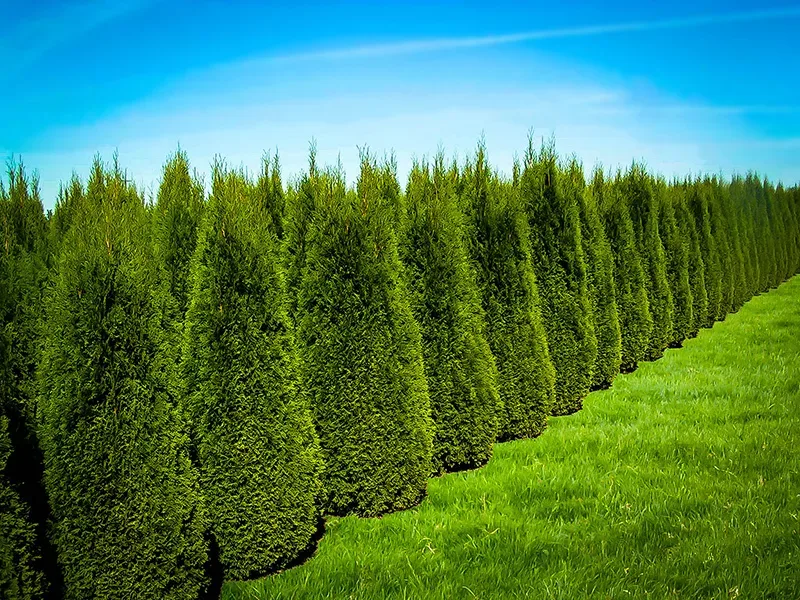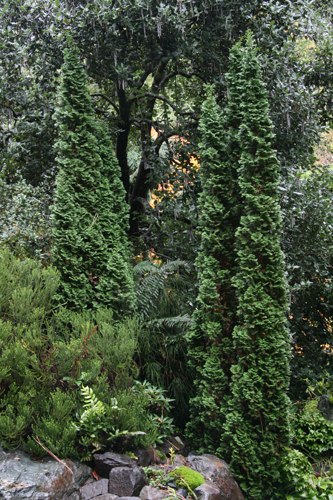
Written by s • Arborvitae Privacy Trees – Pick the Right Tree
Privacy trees are almost always at the top of list for gardeners moving into a new home, or when new buildings go up around you. We all want to feel our house and garden is our own, and nothing does that better than a green screen. All year round. Yet it doesn’t take much driving around to see some pretty big ‘privacy disasters’. The most common is going for that ‘fast-growing tree’ without thinking any further – I know, speed in everything in our society today, faster connections, faster results – and so it’s natural to want that in the garden too. But ‘fast growing’ usually also means ‘big growing’, and before you know it that great bush that made a decent screen in three years is now a towering monster that has engulfed half your garden, throws a giant shadow most of the year, and has your neighbors enraged.
Pick the Right Tree
So what’s the answer? That’s simple – Pick the right tree. Among the trees called Arborvitae there is a privacy tree for every purpose, but it’s important to pick the right one. The one that is the right size for your garden, and the right size and shape for what you need. Let’s take a look. . .
Arborvitae trees are evergreen trees that come from right here in America. Some people call them cedar, but they aren’t a real cedar tree. There are only two wild trees, one from the east and one from the west. Since many of us live in the east, let’s start there:
What are the Advantages of Arborvitae as a Privacy Tree?
Also called white cedar, or eastern arborvitae, and by botanists Thuja occidentalis, you can find arborvitae growing all across the east, around the Great Lakes and the St Lawrence river all the way to the Atlantic. It has some great advantages as a privacy tree choice:
- Very Cold Hardy – ideal for cooler zones down to zone 3, but grow well all the way through zone 7. Lots of other privacy trees are only hardy to zone 5. It takes snow and ice with ease, and doesn’t mind the deep-freeze of the soil that kills so many less-hardy trees.
- Grows in Wet Ground – not every garden has the magical ‘well-drained soil’ that so many plants need, especially lots of evergreens. Arborvitae will grow well at the edge of water, and in areas that are frequently flooded. Since it also grows happily and well in ordinary garden soil, it’s a win-win if you have a wetter-than-average garden, or even just in years where you get a lot of rain.
- Doesn’t Grow Too Large – The most popular variety – Emerald Green – usually tops out around 12 feet or so if left untrimmed, with a width of about 4 feet. With trimming it can easily be kept to 5 or 6 feet for a hedge. Many other privacy trees will reach 30 feet tall and 12 feet wide within 10 or 15 years, creating massive shade and eating up yours (and your neighbor’s) gardens.
- Moderate Growth Rate – this tree won’t grow 3 feet a year, but it will add a respectable 1 to 2 feet a year when young, soon reaching 6 feet, and slow down to 3 to 6 inches once it begins to mature. If your not impressed by that, think of this – a tree that grows 3 feet a year will soon need 3 feet chopped off it every year to stop it growing too large. That means 2 or 3 trimmings a year. Arborvitae can easily be kept at the height you want with just one trim a year, although a second will keep it really neat and tidy.
Arborvitae Varieties for Privacy

The top choice for a basic privacy and hedge tree has got to be the amazing Emerald Green Arborvitae. (It was discovered in Denmark, and it’s proper name is ‘Smaragd’, but that’s a story for another day). It’s dense, upright form, good growth, and especially the way it stays green all through winter, makes it THE hedge and screening tree for privacy in all colder zones. For a screen or hedge, plant those trees 4 feet apart for an untrimmed barrier, or 2 to 3 feet apart for a narrow trimmed hedge – 2 feet for a hedge 5 feet or less, 3 feet for a taller one. It’s a mistake to plant them too close, as it makes it hard to keep the lower section bushy and thick.
If you want to use arborvitae for striking vertical specimens, or want a screen over 12 feet tall, then the tree for you is ‘DeGroot’s Spire’ Arborvitae.
Rising 15 to 25 feet tall in time, but only 4 or 5 feet tall even at full height, this elegant column of green is instantly recognizable by the twisted fans of foliage arranged vertically. It actually looks best untrimmed, but you can trim occasionally to keep it even more dense than it’s natural habit. It grows 6 to 12 inches a year, so just like Emerald Green this isn’t a tree that will eat your yard.
The Western Arborvitae
Although it looks very similar, the second of our native arborvitae is very different. Western Arborvitae, Thuja plicata, is also called western redcedar (yes, it’s where the lumber comes from) and it grows only near the coast in the Pacific northwest. Today it can be found around the world as a lumber tree, and in gardens. For most gardens it’s way too big, but garden forms are more manageable.
Advantages of Western Arborvitae as a Privacy Tree
When it comes to privacy, and you have the room for ‘big’ and ‘fast-growing’, this tree is your top choice.
- Grows Well In all Mild Parts Of The Country – not as cold-hardy as eastern arborvitae, these trees are perfect for zone 5, 6 and 7, in all areas that aren’t really dry in summer.
- Perfect When You Want a Larger Screen – capable of reaching 30 feet tall and 12 feet wide in the garden varieties, these are top choice trees for bigger screens. Remember what we said at the beginning, though – if you don’t have space for ‘big’, then these are probably not the trees for you.
- Fast growth Rate – these are trees where ‘fast-growing’ really applies. You can get 3 feet of new growth every year when they are young, especially from Green Giant. If you want it – here it is.
- Deer Resistant – eastern arborvitae has one weakness, deer will eat it. If you have deer issues (and you are in a warm enough zone) then western arborvitae is your friend. Deer leave it alone, they really do.
- Keep Their Strong Green Coloring Year-Round – the reliable winter color is even bolder than with eastern arborvitae, and we all love a wall of green.
Western Arborvitae Varieties for Privacy

The top choice here has got to be Green Giant, whether you call it Thuja or Arborvitae (opinion is about 50-50 on that). Actually a hybrid, which is where it’s incredible vigor comes from, this really is the very best fast-growing privacy tree around. It can reach 40 feet in height, and be 12 feet or more across, so never plant it in a small garden, or in a confined area. You might be willing to clip it three times a year to keep it at 6 feet, but someone in the future might not be, so don’t leave a nasty legacy.
For a little less height, and not quite so fast growing, consider Spring Grove® Western Arborvitae, properly called ‘Grovepli’. It is a little smaller, reaching no more than 20 to 30 feet, but still spreading to about 12 feet wide. It isn’t quite so fast-growing either, so for hedges you won’t need to trim so often.





